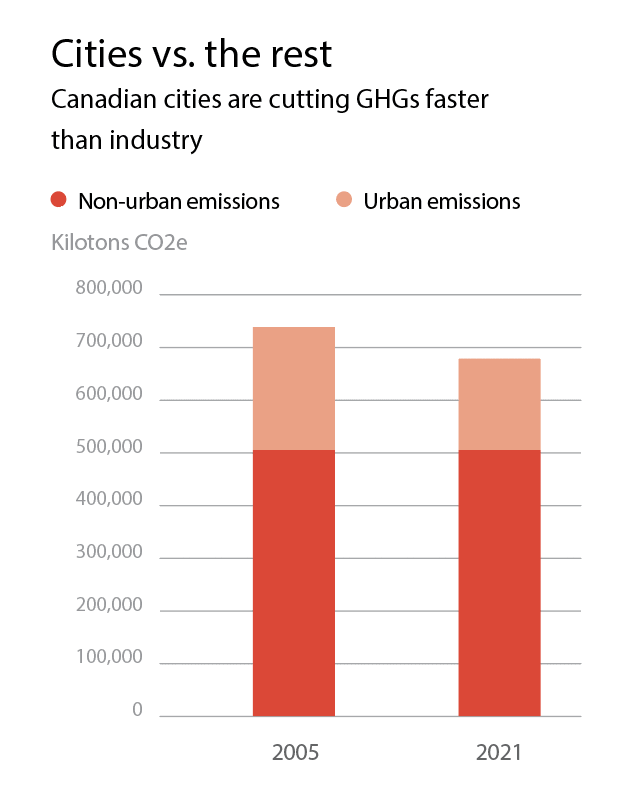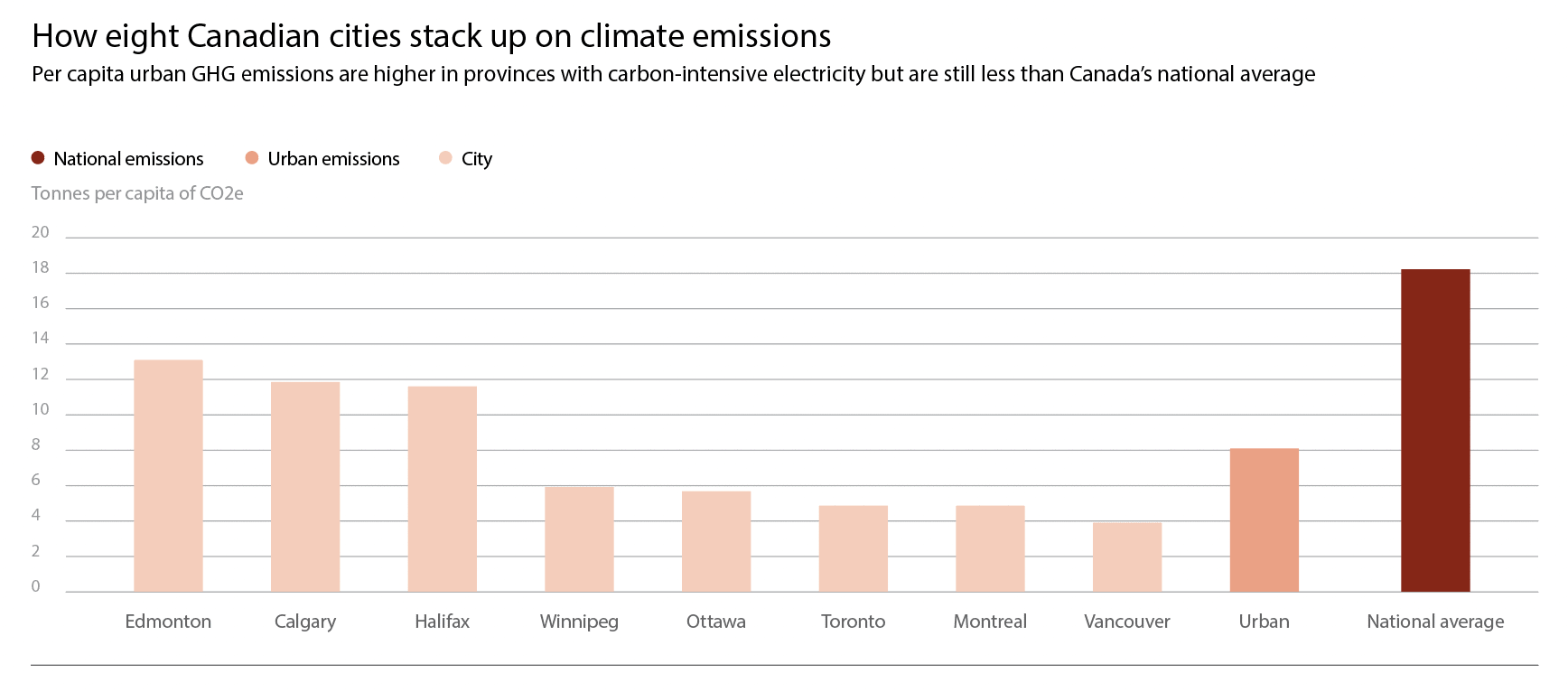Montreal is a famously climate-conscious big city. It has an extensive and fast-growing rapid transit system. The neighbourhoods are dense. Mayor Valérie Plante, a reform-minded progressive who’s held office since 2017, has pushed hard to build separated bike lanes, plant thousands of trees and designate pedestrian-only zones. Last year, she embarked on a project to construct “sponge streets” by replacing some parking spaces with permeable landscapes meant to absorb excess rain and reduce flooding. “Everything about the city now has to [be seen through] this lens – what about climate change?” she said in 2020.
For all that, Montreal struggles to meet its ambitious carbon reduction targets, says Blaise Rémillard, manager of planning and mobility at Conseil régional de l’environnement de Montréal (CRE Montréal), an environmental watchdog group. “We have a lot of good plans and a lot of good targets,” he says. But Montreal’s carbon has climbed since the pandemic, and the prospect for hitting the 2030 mark – 55% below 1990 levels – seems poor. “We don’t really know how we can do a reduction of about one-third of emissions within the next five years.”
The City of Toronto also has an expansive net-zero plan, dubbed TransformTO, as well as one of North America’s few municipal policies (the Toronto Green Standard) designed to push builders to drive energy efficiency beyond the low bar in the Ontario Building Code. But it suffers from the same dilemma. TransformTO, says Sarah Buchanan, campaigns director at the Toronto Environmental Alliance, “still doesn’t have the energy, funding and oomph behind it to make it do what council committed to.” Case in point: city council finally approved, but has not yet allocated funding for, a waterfront LRT meant to provide transit access to existing and planned high-density developments on Toronto’s de-industrialized port lands.
A few other cities have fared better when it comes to putting their money where their mouths are. Halifax Regional Municipality last year imposed a climate change tax as a pillar of its broader sustainability strategy, dubbed HalifACT. “At the time, it was the only one of its kind across Canada, and that had some really contentious public support,” says Kortney Dunsby, sustainable cities co-ordinator at the Ecology Action Centre in Halifax. The funding has gone toward investments such as building retrofits.
However, recent population growth and housing price spikes in the Halifax region appear to be driving sprawl as developers snap up cheap land along the region’s edges, with little resistance from the municipality and little in the way of transit investment to service those emerging communities. “Greenfield development [i.e., building projects on completely undeveloped land, such as farmers’ fields] is becoming a conversation, which is sometimes at odds with our climate plan,” observes Ahsan Habib, a professor at Dalhousie University and director of the Dalhousie Transportation Collaboratory.

The problem with city climate plans
As Canada has become more urbanized, greenhouse gas emissions from Canadian urban communities have declined by 17% from 1990 levels. Meanwhile, emissions from the rural economy – heavy industry, mining, oil and gas, agriculture and intercity transport – have increased by 30% over the same period. Since 2005, moreover, urban emissions have fallen by more than a quarter, while rural emissions from those same sectors have remained stable. Both statistics show that cities are driving Canada’s progress toward its 2030 targets.
Still, there’s a chasm between what municipal climate plans call for and what they actually deliver, and that fact of urban life is not new. Sustainability consultant Jeb Brugmann, the founder of Resilient Cities Catalyst, describes it as “the implementation gap,” adding that this type of shortcoming stems from the fact that municipal climate strategies originally took hold among planners. “Part of the planning conceit,” he says, “is that if you do planning, somehow it triggers implementation.” In his experience, climate plans falter because city officials don’t follow through by then doing the hard work of hacking through the Gordian knot of regulatory and cultural obstacles to change.

Others point out that these strategies may do little more than reinforce actions cities were already taking. A decade ago, then–McGill University geographer Adam Millard-Ball did a deep dive into the climate plans and policies for 600 U.S. cities and concluded that in most cases, they simply reflected the prevailing political preferences of individual cities, and spelled out actions that would have likely happened with or without an overarching strategy.
“Cities with climate plans have had far greater success in implementing strategies to reduce greenhouse gas emissions than their counterparts without such plans,” he wrote in the Journal of Urban Economics. “They have more green buildings, spend more on pedestrian and bicycle infrastructure, and have implemented more programs to divert waste from methane-generating landfills. I find little evidence, however, that climate plans play any causal role in this success.”
Part of the explanation for the buyer’s regret with climate plans can be found in the tangle of overlapping jurisdictions that touch the climate file and make it exceedingly difficult for cities to drive ahead with solutions. In Montreal, mobility-related emissions have remained stubbornly high because the province continues to pour money into highways. While EV adoption is impressive thanks to subsidies and the deployment of charging infrastructure (see p. 38), EV owners will drive instead of taking transit, which remains a far more climate-friendly solution.
As for energy, Montrealers rely in part on cheap natural gas because Hydro-Québec has long exported the province’s surplus hydro power and relied instead on “peaker plants.” (Even though 94% of the province’s electricity capacity is hydroelectric, fossil fuels account for more than half of all the energy consumed in Quebec.) Rémillard describes Quebeckers’ view of natural gas as “complacent.” In Toronto, the city incentivizes builders to disconnect from natural gas, but the provincial government has continued to expand Enbridge’s gas distribution network.
[TransformTO] still doesn’t have the energy, funding and oomph behind it to make it do what council committed to.
- Sarah Buchanan, Toronto Environmental Alliance
What’s more, the story of hobbled city-driven climate mitigation or adaption plans is also a function of regulatory inertia. In most jurisdictions, for example, building codes – that is, minimum standards for fire and structural safety, energy efficiency, et cetera – are set at the provincial or state level, which means municipalities are limited in how effectively they can push developers, using their own permitting systems, to reduce building-related carbon.
Of course, emissions don’t care about administrative borders. Yet administrative borders determine municipal climate action plans, such as transit investment. The result is that suburban areas, which tend to be car-dependent because of sprawl-oriented planning policies made decades ago, may care much less about spending on transit, not necessarily because their mayors and councils are climate dinosaurs, but because transit infrastructure in low-density areas is incredibly expensive.
The analysis becomes even trickier depending on what type of urban carbon we’re choosing to measure. According to a 2020 peer-reviewed study published in the journal Sustainability, city climate strategies typically focus on the production of carbon, via tailpipe emissions, energy generation and so on. But if you widen the focus to include consumption-related carbon – for instance, carbon generated by the manufacture and distribution of consumer goods purchased in the city, everything from food to consumer electronics, and including the supply chains that lead to urban markets – the total is considerably higher. Paradoxically, cities with ambitious climate plans may also be wealthier, which means more consumption and thus more carbon.
All of these cross-currents butt up against one of the more dominant strains of climate politics, which is that global cities and their mayors have established themselves at the vanguard of carbon reduction, often in response to the lack of effective policy from national governments. Organizations like the C40, an international network of sustainability-minded cities, work hard to promote ambitious strategies, pilot projects and technologies that have moved the needle in various metropolitan areas.

Tough questions hover around the achievability of these urban sustainability goals that depend primarily on government investments but lack proper enforcement mechanisms and penalties. Some cities are beginning to think in those terms. At the Toronto Environmental Alliance, Buchanan points out that the City of Toronto is looking at a proposal to compel the owners of larger commercial structures to disclose their carbon consumption – a figure that, theoretically, might cause tenants to think twice about energy-inefficient buildings and the unnecessarily high energy costs they may incur in their lease arrangements. Eventually, she adds, landlords may face fines or fees for failing to upgrade their buildings, but city council hasn’t signed off yet on such a move.
There’s evidence from elsewhere that tougher policies do work. In New York City, for example, Local Law 97, which was enacted in 2019 and comes into effect this year, sets emissions caps on buildings of a certain size, with non-compliant landlords facing hefty fines. The regulation applies to 50,000 properties that exceed 25,000 square feet in total area. City officials say the vast majority of landlords have already moved to comply with the 2024 target reduction, but they’ll have to push even further to satisfy the 2030 benchmark (40% reductions).
The other conundrum is whether overly broad city climate plans become bureaucratically unmanageable because of their breadth of ambition – the “too much body/not enough blanket” problem. Asked to identify the most impactful municipal climate policy, the Ecology Action Centre’s Dunsby replies, “In planning, we call these wicked planning problems.” Halifax’s housing crisis isn’t unique to this city, she adds, “but I do think that focusing housing development in already serviced areas and focusing on trying to build out truly complete communities – mixed-use, walkable, transit-oriented development – would truly help to reduce our community-scale emissions.”

A large body of evidence confirms that land-use planning and development that drives density is, in fact, among the most effective ways to cut urban emissions. In a paper published this spring in the journal Cities, an American-Mexican team of geographers scrutinized land-use regulation in 431 urban areas in 40 countries. “Our findings confirm that dense, compact urban areas, with built-up downtowns and shorter roadway segments, have lower per capita carbon emissions,” they concluded, adding that restrictions on intensification, such as the protection of low-rise neighbourhoods, fuels sprawl and all the carbon that sprawl brings.
But both Buchanan and Dunsby caution against the notion that there’s a silver bullet when it comes to decarbonizing cities. “The investment in accelerating housing development and density has to come at the same time as investing in really high-functioning, efficient and reliable transit systems,” Dunsby says.
[Burnaby’s Metrotown is] a very unique hub. That ain’t no 15-minute city. That’s a five-minute city.
- Jeb Brugmann, founder, Resilient Cities Catalyst
Indeed, Ahsan Habib and many other climate-conscious planners argue that cities need to make decisions on how they grow and develop in lockstep with investments in green transportation infrastructure. “Whenever we are growing certain parts of the city, do we have a plan in place to move those people [and] achieve certain target modal splits [i.e., the proportion of people who travel by transit, bike or foot as opposed to cars]? If we do that, there is no chicken-and-egg problem.”
Brugmann points out that in some cities, strong political leaders have broken down silos that too often stand in the way of urban climate action. He cites the case of Curitiba, Brazil, where a long-serving mayor with no patience for official plans used his power to build an extensive bus rapid-transit network, a formula now in use in many large Latin American cities.
He also cites examples closer to home, such as Metro Vancouver, where far-sighted planning and investment led, over three decades, to high-density development in the West End and impressive intensification around the expanding SkyTrain network. Brugmann lived for several months in Metrotown – a dense, transit-oriented community in Burnaby that’s grown up over the past two decades or so and seems to be delivering on the vision of a compact, pedestrian-friendly community connected to the region by transit. “It’s a very unique hub,” he says. “I’m telling you, that ain’t no 15-minute city. That’s a five-minute city.”
For our spring issue, Corporate Knights looks at a handful of urban indicators – greenhouse gases per capita, tree canopy and EV charging infrastructure – in eight large cities across Canada. Check back here for more city features from our Spring 2024 issue.
John Lorinc is a Toronto-based journalist and author specializing in urban issues, business and culture.





